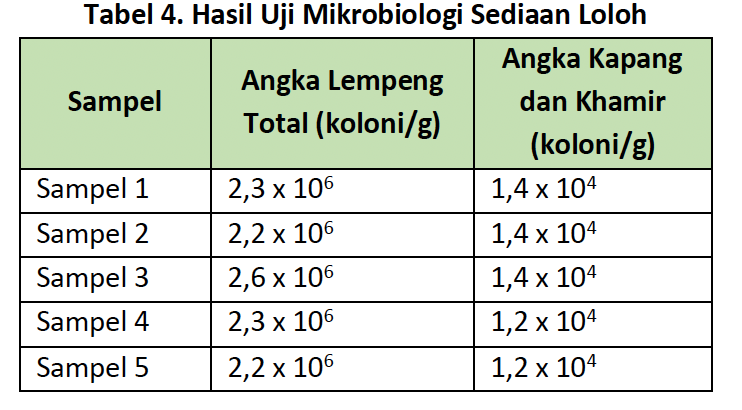Physical Characteristics, Microbiological Evaluation, and Phytochemical Screening of Loloh Formulated from Jempiring, Pegagan, Katuk Leaves, and Coconut Water
DOI:
https://doi.org/10.36733/usadha.v4i02.7362Keywords:
loloh traditional beverage, physical evaluation, phytochemical screening, Total plate count (TPC), Yeast and mold count (YMC)Abstract
Loloh is a traditional herbal beverage specifically produced by the Balinese community to prevent and treat various ailments. One example of loloh used for health maintenance can be formulated from a mixture of jempiring leaves (Gardenia jasminoides), pegagan leaves (Centella asiatica), katuk leaves (Breynia androgyna), and coconut water (Cocos nucifera). A major challenge in loloh production is the risk of microbial contamination. This study aims to examine the physical characteristics, bioactive compound profile, and microbiological quality of loloh formulated from a combination of jempiring leaves (G. jasminoides), pegagan leaves (C. asiatica), katuk leaves (B. androgyna), and coconut water (C. nucifera). The research employed an experimental design with a descriptive approach. Observed variables included organoleptic characteristics (color, form, odor), pH, microbiological parameters (total plate count [TPC] and yeast and mold count [YMC]), and phytochemical screening of the loloh preparation. The samples used in this study were loloh packaged in 250 ml bottles. A total of six bottles were used, with five allocated for microbiological testing and one for phytochemical screening. The resulting loloh exhibited a brown color, a distinctive odor, and a pH of 6. All five microbiological samples showed microbial contamination exceeding the permissible limits, with TPC values surpassing 10⁶ CFU/g and YMC values exceeding 10⁴ CFU/g. Phytochemical screening revealed the presence of alkaloids, flavonoids, saponins, tannins, and steroids. It can be concluded that loloh is rich in bioactive compounds; however, hygienic practices and microbiological safety must be carefully considered, particularly during production and packaging processes.
References
[1] Pebiana NPN, Puspasari YD, Dewi RM, Arnyana IBP. Kajian Etnobotani Loloh dan Teh Herbal Lokal sebagai Penunjang Ekonomi Kreatif Masyarakat Desa Tradisional Penglipuran Kabupaten Bangli-Bali. Bioma: Berkala Ilmiah Biologi 2021; 23(2): 91–99.
[2] Indri H, Pratiwi K, Wiadnyani S, Widarta R. Kajian Nilai Gizi Minuman Tradisional Bali. Jurnal Agrotekno 2015;17(2)
[3] Biswas D, Mandal S, Chatterjee Saha S, Tudu CK, Nandy S, Batiha GE, Shekhawat MS, Pandey DK, Dey A. Ethnobotany, phytochemistry, pharmacology, and toxicity of Centella asiatica (L.) Urban: A comprehensive review. Phytotherapy Research 2021; 35(12): 6624–6654.
[4] Phatak RS. Phytochemistry, pharmacological activities and intellectual property landscape of Gardenia jasminoides Ellis: a review. Pharmacognosy Journal 2015; 7(5).
[5] Rahayu NKT, Permana I, Puspawati G. Pengaruh Waktu Maserasi Terhadap Aktivitas Antioksidan Ekstrak Daun Pegagan (Centella asiatica (L.) Urban). Jurnal Itepa 2020; 9(4): 482–489.
[6] Zhang B, Cheng J, Zhang C, Bai Y, Liu W, Li W, Koike K, Akihisa T, Feng F, Zhang J. Sauropus androgynus L. Merr.-A phytochemical, pharmacological and toxicological review. Journal of Ethnopharmacology 2020; 257.
[7] Lima EBC, Sousa CNS, Meneses LN, Ximenes NC, Júnior S, Vasconcelos GS, Lima NBC, Patrocínio MCA, Macedo D, Vasconcelos SMM. Cocos nucifera (L.)(Arecaceae): A phytochemical and pharmacological review. Brazilian Journal of Medical and Biological Research 2015; 48: 953–964.
[8] Nadila E, Azzahro F, Hasanah FY, Proverawati A. Composition And Potency Of Young Coconut Water For Health (Cocos nucifera L.): A Systematic Review. International Journal of Biomedical Nursing Review 2022; 1(1): 10–18.
[9] Rashid MMO, Islam MS, Haque MA, Rahman MA, Hossain MT, Hamid MA. Antibacterial activity of polyaniline coated silver nanoparticles synthesized from Piper betle leaves extract. Iranian Journal of Pharmaceutical Research 2016; 15(2): 591–597.
[10] Venugopal A, Joseph D. Cocos nucifera: It’s pharmacological activities. World Journal of Pharmaceutical Sciences 2017; 195–200.
[11] Pratiwi IDPK, Suter IK, Widpradnyadewi PAS, Wiadnyani AAIS. Pengaruh Penyimpanan pada Suhu Kamar Terhadap Sifat Mikrobiologis Loloh Bluntas yang Diproduksi di Daerah Denpasar-Badung. Media Ilmiah Teknologi Pangan 2016; 3(2): 135–140.
[12] Badan Pengawasan Obat dan Makanan Republik Indonesia. Pedoman Kriteria Cemaran pada Pangan Siap Saji dan Pangan Industri Rumah Tangga. 2012.
[13] Kementerian Kesehatan Republik Indonesia. Farmakope Indonesia Edisi VI. Kementerian Kesehatan Republik Indonesia. 2020.
[14] Kesavan K, Gnanasekaran J, Gurunagarajan S, Nayagam AAJ. Microscopic, physicochemical and phytochemical analysis of Gardenia jasminoides (Ellis). International Journal of Pharmacy and Pharmaceutical Sciences 2018; 97–102.
[15] Ogunka-Nnoka CU, Igwe FU, Agwu J, Peter OJ, Wolugbom PH. Nutrient and phytochemical composition of Centella asiatica leaves. Med Aromat Plants (Los Angeles) 2020; 9(2): 412–2167.
[16] Badan Pengawas Obat dan Makanan, R. I. Peraturan Badan Pengawas Obat Dan Makanan Nomor 13 Tahun 2019 Tentang Batas Maksimal Cemaran Mikroba Dalam Pangan Olahan. 2019.
[17] Sugianti GR, Wirawan IMA, Utami NWA. Microbiological quality, hygiene, and sanitation of the production processes of a traditional beverage at tourism areas in Bali. Journal of UOEH 2019; 41(4): 353–362.
[18] Dion R, Purwantisari S. Analisis Cemaran Kapang dan Khamir pada Jamu Serbuk Instan Jahe Merah dan Temulawak. Berkala Bioteknologi 2020; 3(2)
[19] Pratiwi IDPK, Suter IK, Widpradnyadewi PAS, Wiadnyani AAIS. Perubahan fisiko-kimiawi dan mikrobiologis minuman tradisional bali (loloh) selama penyimpanan. Agritech 2019, 39(1): 70–77.
[20] Wipradnyadewi PAS, Yusasrini NLA. Cemaran Mikrobiologis Pada Beberapa Loloh Bali Di Kota Denpasar. Media Ilmiah Teknologi Pangan 2017; 4(1): 43–51.

Downloads
Published
Issue
Section
License
Copyright (c) 2025 Made Puspawati, Dwi Arymbhi Sanjaya, Ni Nyoman Yudianti Mendra

This work is licensed under a Creative Commons Attribution-NonCommercial 4.0 International License.




